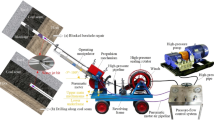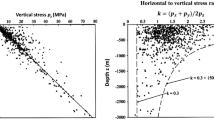Abstract
To analyze mining hydrogeological conditions and determine the sources of mine water, a hydrothermal deposit of China is taken as an example in this paper. On the basis of detailed geological and hydrogeological analysis of conditions in the mining area, the hydrogeological characteristics of a fault system of F1 in this mine are determined using a pumping test method and isotope technology. Hydraulic connections between the Majiagou group and Xiaoxian group are given a detailed illustration. The results show that the F1 group of faults is channeling water. Under significant drawdown, fissure water and Lower Pleistocene porous confined water are indirect sources of mine water, but water supply in unit time is limited. According to the analysis results, water will enter the pit during mining at a rate of 12,680 m3/d. In contrast, if the transmission performance of the F1 group of faults is ignored, the porous confined water will not enter the pit, and the mine water inflow will be 9700 m3/d. This is a decrease of 2980 m3/d, accounting for 30.72 % of mine water inflow. Therefore, the effect of water sources on mine water inflow cannot be ignored.





Similar content being viewed by others
References
Bezdek JC (1981) Pattern recognition with fuzzy objective function algorithms. Kluwer Academic Publishers, Norwell 256
Coplen TB (1994) Reporting of stable hydrogen, carbon, and oxygen isotopic abundances. Pure Appl Chem 66:273–276
Coplen TB, Wildman JD, Chen J (1991) Improvements in the gaseous hydrogen-water equilibration technique for hydrogen isotope ratio analysis. Anal Chem 63:910–912
Doulati Ardejanii F, Rooki R, Jodieri Shokri B, Eslam Kish T, Aryafar A, Tourani P (2013) Rare earth elements prediction in neutral alkaline mine drainage from the Razi coal mine of the Golestan Province, northeast Iran using general regression neural network. J Environ Eng 139(6):896–907
Epstein S, Mayeda T (1953) Variation of O-18 content of water from natural sources. Geochim Cosmochim Acta 4:213–224
Gat JR (1996) Oxygen and hydrogen isotopes in hydrologic cycle. Annu Rev Earth Planet Sci 24:225–262. doi:10.1146/annurev.earth.24.1.225
Jakubick A, Jenk U, Kahnt R (2002) Modelingofmine flooding and consequences in the mine hydrogeological environment: flooding of the Koenigstein mine, Germany. Environ Geol 42:222–234
Lee D, Yim G-J, Ji S-W, Cheong Y-W (2012) Study on distribution characteristics of some water parameters properties of mine drainage in an oxidation pond, Hwangji-Yuchang coal mine, South Korea. Environ Earth Sci. doi:10.1007/s12665-012-1735-7
Liu PG, Tao YZ, Shang MT, Yao M (2014) The calculation of mine water yield using the non-continuous flow theory. Environ Earth Sci. doi:10.1007/s12665-013-2592-8
Parizi HS, Samani Nozar (2014) Environmental isotope investigation of groundwater in the Sarcheshmeh copper mine area, Iran. Mine Water Environ 33:97–109
Pourjabbar A, Sârbu C, Kostarelos K, Einax JW, Büchel G (2014) Fuzzy hierarchical cross-clustering of data from abandoned mine site contaminated with heavy metals. Comput Geosci 72:122–133
Qian JZ, Zhan HB, Zhao WD, Sun FZ (2005) Experimental study of turbulent unconfined groundwater flow in a single fracture. J Hydrol 311:134–142
Révész K, Coplen TB (2007) Determination of the d(2H/1H) of water: RSIL lab code 1574. In: Révész K, Coplen TB (eds) Methods of the Reston Stable Isotope Laboratory, US Geological Survey, techniques and methods (Book 10, sec. C, Chapter 1)
Révész K, Coplen TB (2008) Determination of the d(18O/16O) of water: RSIL Lab Code 489. In: Révész K, Coplen TB (eds) Methods of the Reston Stable Isotope Laboratory. US Geological Survey, Techniques and Methods, (Book 10, sec. C, Chapter 2)
Rooki R, Doulati Ardejani F, Aryafar A, Bani Asadi A (2011) Prediction of heavy metals in acid mine drainage using artificial neural network (ANN) from the Shur River of the Sarcheshmeh porphyry copper mine, Southeast Iran. Environ Earth Sci 64:1303–1316
Todd DK, Mays LW (2005) Groundwater hydrology, 3rd edn. Wiley, New York
Verhagen BTH, Geyh MA, Froehlich K, Wirth K (1991) Isotope hydrological methods for the quantitative evaluation of groundwater resources in arid and semi-arid areas. Federal Ministry for Economic Cooperation, Development of a methodology, Bonn, p 164
Vermeulen PD, Burger M, van Wyk A, Lukas E (2014) Using environmental isotopes in a coal mine and a gold mine to determine groundwater interaction. Mine Water Environ 33:15–23
Walton-Day K, Poeter E (2009) Investigating hydraulic connections and the origin of water in a mine tunnel using stable isotopes and hydrographs. Appl Geochem 24:2266–2282
Wu Q, Fan S, Zhou W (2013) Application of the analytic hierarchy process to assessment of water inrush: a case study for the No. 17 coal seam in the Sanhejian coal mine, China. Mine Water Environ 32:229–238
Yao HM, Vuthaluru HB, Tade MO, Djukanovic D (2005) Artificial neural network-based prediction of hydrogen content of coal in power station boilers. Fuel 84:1535–1542
Acknowledgments
This work was supported in part by the National Natural Science Foundation of China Grants 51309071 and 51509064.
Author information
Authors and Affiliations
Corresponding author
Rights and permissions
About this article
Cite this article
Yao, M., Liu, P., Shang, M. et al. Determining sources of mine water based on hydraulic characteristics analysis of a fault system. Environ Earth Sci 75, 858 (2016). https://doi.org/10.1007/s12665-016-5660-z
Received:
Accepted:
Published:
DOI: https://doi.org/10.1007/s12665-016-5660-z




